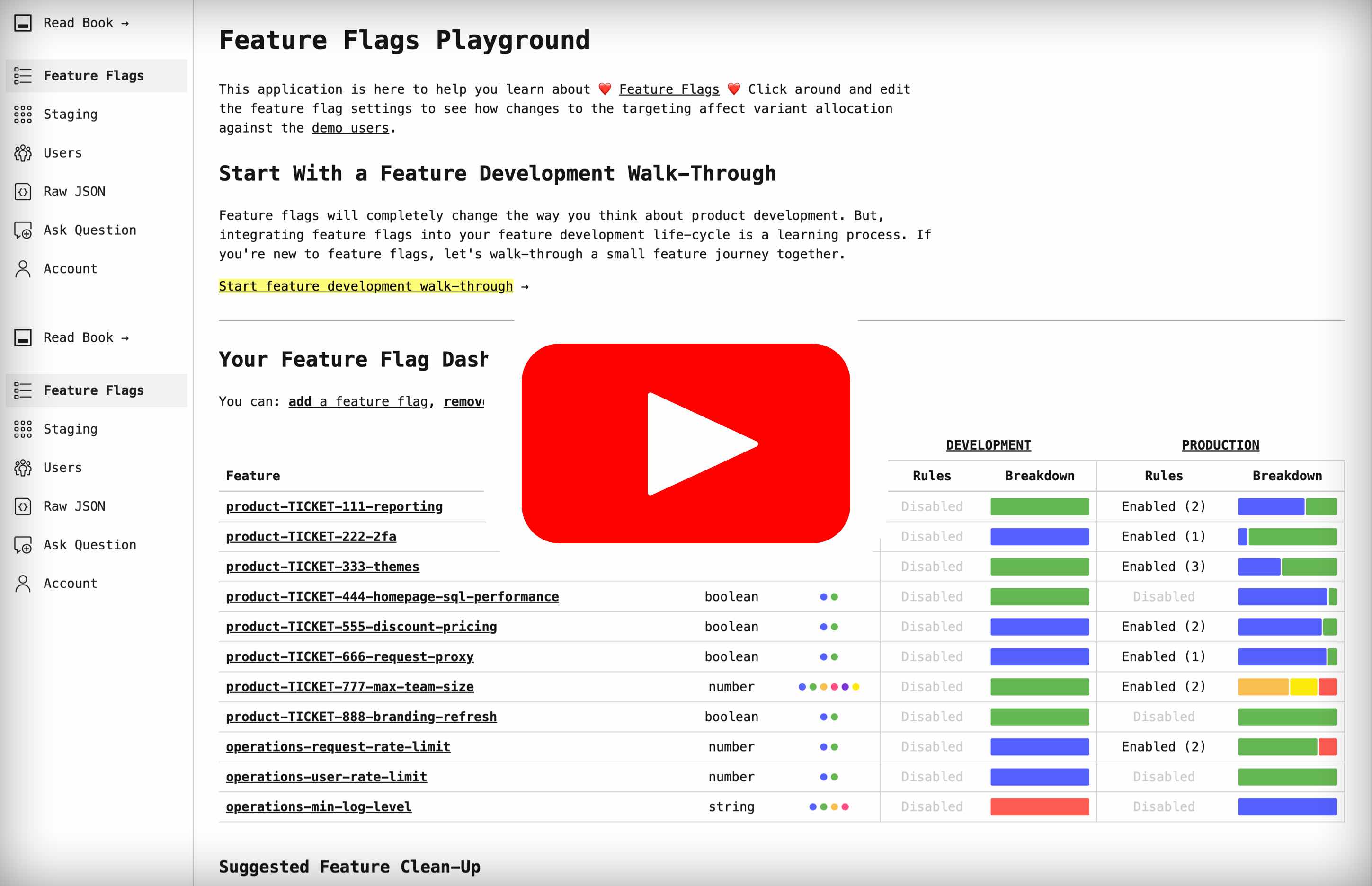by Ben Nadel
As a fun experiment, I wanted to build a small playground companion to my Feature Flags Book. This is a place where readers can log into a system and try creating feature flags and updating targeting rules to get a sense of how a feature flags / feature toggles system can be used.
A feature flags system is really just a rules engine that takes application-provided inputs (such as userID or userEmail), funnels them through a set of rules, and then returns a predictable and repeatable result. Meaning, the same inputs will always yield the same result as long as the configured rules have not changed.
The majority of feature flags that I use are Boolean types that conditionally enable new feature experiments and performance improvements. For these types of flags, a finite set of variants along with a percent-based distribution makes a lot of sense — it allows you to incrementally roll-out a new feature; and, to react quickly to any early signs of a problem.
For some types of operational feature flags, however, dealing with a finite set of variants and a percent-based allocation feels unnatural. In those cases, a little more flexibility creates for better developer ergonomics.
To enable this kind of flexibility, each feature flag (and rule) will have a resolution type. This resolution type can be one of three flavors:
-
selection- defines the index of the variant to be returned. -
distribution- defines the weighted distribution across all variants. -
variant- defines an override variant value (of the same type) to be returned regardless of the initial set of variants.
To demonstrate, consider the set of log-level variants:
{
variants: [ "error", "warn", "info" ]
}In a production environment, we might want all users to receive the error variant. And, since this is the first element in the variants array, we could use a selection resolution type with value, 1:
{
variants: [
"error", // 1st variant.
"warn", // 2nd variant.
"info" // 3rd variant.
],
targeting: {
production: {
resolution: {
type: "selection",
selection: 1 // Returns `error` for all users.
}
}
}
}However, in the middle of an incident, we might need to move to a lower-level of logging in order to debug the problem. However, so as to not overwhelm the log aggregation mechanism, perhaps we only want 10% of users to start emitting warn logs. In that case, we could use a distribution resolution type that allocates error to 90% of users, warn to 10% of users, and info to 0% of users:
{
variants: [ "error", "warn", "info" ],
targeting: {
production: {
resolution: {
type: "distribution",
distribution: [ 90, 10, 0 ] // 10% of users get `warn`.
}
}
}
}Now, imagine that the defined log-level aren't enough to give us the information that we need to debug the problem. We could, in desperation, move every user to a trace log-level. And, since trace isn't in the set of predefined variants, we would use the variant resolution type to provide an override value:
{
variants: [ "error", "warn", "info" ],
targeting: {
production: {
resolution: {
type: "variant",
variant: "trace" // An override value.
}
}
}
}When you log into the feature flags playground, your user will be allocated a unique collection of feature flags to be persisted in a JSON file. The following JavaScript represents the structure of said file.
{
email: "ben@bennadel.com",
version: 13,
// The set of feature flags is shared across all environments. However,
// each feature will have its own unique set of targeting rules.
environments: {
production: {
name: "Production",
description: ""
},
development: {
name: "Development",
description: ""
}
},
features: {
"product-TICKET-13-feature-x": {
type: "boolean",
description: "I determine if Feature X is enabled.",
// The set of values that can be allocated via selection or
// distribution resolution modes.
variants: [ false, true ],
// The default selection (variant index) to be used when creating
// the environment entries.
defaultSelection: 1,
targeting: {
production: {
resolution: {
type: "distribution",
distribution: [ 50, 50 ]
},
// If rules aren't enabled, the resolution above is used.
rulesEnabled: true,
rules: [
{
input: "group",
operator: "IsOneOf",
values: [ "beta-testers" ],
// When a rule matches, it will override the above
// resolution.
resolution: {
type: "selection",
selection: 2 // The `true` variant.
}
},
{
input: "companySubdomain",
operator: "IsOneOf",
values: [ "example", "acme" ],
// Or, a rule can override the actual variant (as
// long as the value is of the same type).
resolution: {
type: "variant",
variant: false // Never enable for matches.
}
}
]
},
development: {
resolution: {
type: "selection",
selection: 2
},
rulesEnabled: false,
rules: []
}
}
},
"operations-ip-rate-limit": {
// ....
}
}
}You may notice that the environments, features, and targeting properties all reference structs. I've chosen to use structs here, instead of arrays, because they make look-ups much easier. For example, when checking to see if a given environment or feature exists, it's comparatively simple to perform a keyExists(featureKey) check rather than looping over an array and comparing element properties.
